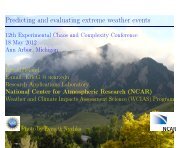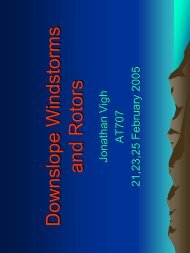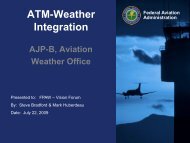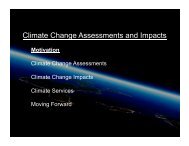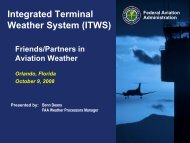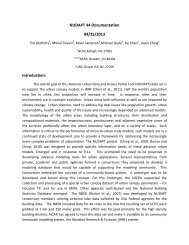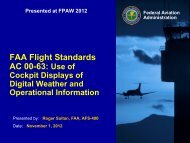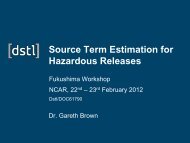MODE (Method for Object-based Diagnostic Evaluation)
MODE (Method for Object-based Diagnostic Evaluation)
MODE (Method for Object-based Diagnostic Evaluation)
You also want an ePaper? Increase the reach of your titles
YUMPU automatically turns print PDFs into web optimized ePapers that Google loves.
<strong>MODE</strong> (<strong>Method</strong> <strong>for</strong> <strong>Object</strong>-<strong>based</strong><br />
<strong>Diagnostic</strong> <strong>Evaluation</strong>)<br />
<br />
NCAR<br />
<br />
Davis, Brown, and Bullock, 2006. <strong>Object</strong>-<strong>based</strong><br />
verification . . . Part I & II. Mon. Wea. Rev. 134,<br />
1772–1795.
<strong>MODE</strong> Input<br />
<br />
<br />
<br />
<br />
<br />
Gridded text files with lat-lon info<br />
GRIB<br />
Precipitation rate or accumulation<br />
Reflectivity<br />
Any field that can be thought of as “objects”
<strong>MODE</strong> <strong>Object</strong> Identification<br />
2 parameters:<br />
1. Convolution radius<br />
2. Threshold
Identifying and<br />
Merging <strong>Object</strong>s<br />
1 June, 2005 1-hour precip<br />
Solid blue blobs:<br />
Convolution radius 15 grid pts<br />
Precip threshold 0.05”<br />
Thin outline<br />
Precip threshold 0.0125”
Fuzzy logic mergers<br />
Centroid distance
Fuzzy logic mergers<br />
Minimum<br />
boundary distance
Fuzzy logic mergers<br />
orientation
Matching Observed & Forecasted <strong>Object</strong>s<br />
observed objects<br />
False alarms
Fuzzy logic matches<br />
Overlap<br />
Size ratio<br />
Median intensity<br />
ratio<br />
Complexity ratio
<strong>MODE</strong> output<br />
<br />
<br />
<br />
<br />
<br />
Attributes of composite observed and <strong>for</strong>ecast objects and their<br />
relationships<br />
− EX: Area, Intensity, Volume, Location, Shape, + differences and ratios<br />
Attributes of single matched shapes (i.e., “Hits”)<br />
Attributes of single unmatched shapes (i.e., “False Alarms”,<br />
“Misses”)<br />
Attributes of interest to specific users (e.g., gaps between storms,<br />
<strong>for</strong> aviation strategic planning)<br />
Attributes can be summarized across many cases to<br />
−<br />
−<br />
−<br />
−<br />
Understand how <strong>for</strong>ecasts represent the storm/precip climatology<br />
Understand systematic errors<br />
Document variability in per<strong>for</strong>mance in different situations<br />
Etc.
<strong>MODE</strong> Strengths and Weaknesses<br />
<br />
Strengths<br />
− Allows and quantifies spatial offsets<br />
− Gives credit to a “good enough” <strong>for</strong>ecast<br />
− Tuned to particular object intensity and size<br />
<br />
Weaknesses<br />
− Many tunable parameters
Convolution radius / Intensity<br />
threshold<br />
fraction of single objects matched<br />
00 UTC, 1 June 2005<br />
Precipitation threshold<br />
radius
June 1, 2005<br />
ARW 2-km<br />
ARW 4-km<br />
Displacement<br />
22.6km<br />
Displacement<br />
24.6km
<strong>MODE</strong> <strong>Object</strong>-<strong>based</strong> approach<br />
Identification<br />
Measure<br />
Attributes<br />
Merging<br />
Matching<br />
Comparison<br />
Summarize<br />
Convolution – threshold<br />
process<br />
Fuzzy Logic Approach<br />
Merge simple objects into<br />
composite objects<br />
Compute interest values<br />
Identify matched pairs<br />
Accumulate and examine<br />
comparisons across many<br />
cases
Gridded <strong>for</strong>ecast example: Summary<br />
Locations:<br />
Forecast objects are<br />
• Too far North (except B)<br />
• Too far West (except C)<br />
Precipitation intensity:<br />
• Median intensity is too large<br />
B f<br />
C f<br />
D f<br />
Forecast<br />
A f<br />
POD = 0.27<br />
FAR = 0.75<br />
CSI = 0.34<br />
C o<br />
B o<br />
D o<br />
Observed<br />
A o<br />
• Extreme (0.90 th) intensity is too small<br />
Size:<br />
• Forecasts C and D are too small<br />
• Forecast B is somewhat too large<br />
Matching:<br />
• Two small observed objects were<br />
not matched
Example: Summary across many<br />
<strong>for</strong>ecasts<br />
Does precipitation intensity vary between<br />
Forecast and Observed objects?<br />
Median<br />
0.90 th Quantile<br />
S = Stage 4 precip (Observed); W = WRF Forecast
Application examples:<br />
Distribution of spatial errors<br />
y f -y o<br />
Distribution of Spatial Errors<br />
x f -x o
Matching and Forecast “Skill”<br />
Much greater<br />
dependence of<br />
<strong>for</strong>ecast error on<br />
the size of objects<br />
than on <strong>for</strong>ecast<br />
lead time<br />
Match<br />
Fcst<br />
YY<br />
NY<br />
Obs<br />
YN<br />
CSI=YY/(YY+NY+YN)
Quilt plots <strong>for</strong> different models
June 1, 2005<br />
ARW 4-km<br />
NMM 4-km<br />
Displacement<br />
24.6km<br />
Displacement<br />
14.6km<br />
Displacement<br />
30 km<br />
Displacement<br />
19 km
Percent of single objects matched<br />
1 June 2005 9 Cases<br />
<br />
<br />
Region with large radius and large threshold has low rate of<br />
matches, except <strong>for</strong> most extreme values<br />
Region with moderate values of radius and low threshold<br />
(around 5) is the scale with best potential <strong>for</strong> object matching
7-30h <strong>for</strong>ecast animations<br />
May 13, 2005<br />
June 1, 2005
2005 0513 2005 0601
24-h fcst valid 1Jun 2005, 00 UTC<br />
R=15 T=.05” R=10 T=.10”
14<br />
12<br />
hit<br />
10<br />
8<br />
6<br />
4<br />
2<br />
false alm<br />
miss<br />
0<br />
1 3 5 7 9 11 13 15 17 19 21 23<br />
UTC
3 Fake <strong>for</strong>ecasts<br />
<br />
Real observations<br />
− Shifted 50 grid points (~200 km) southeast<br />
− Same shift and scaled 2x<br />
− Same shift with 0.05” subtracted
1 June 2005 9 Cases



